President Ferdinand Marcos Jr. on Sunday tapped the brakes on the planned ₱8.7 billion rehabilitation of Epifanio de los Santos Avenue (EDSA), instructing government agencies to explore more effective and less disruptive alternatives to upgrade the capital’s most critical thoroughfare.
The controversial rehabilitation project was set to begin on June 13, immediately after Independence Day, and continue through 2027. The plan, which involved partial closures of EDSA—a 24-kilometer artery that cuts across five cities and accommodates an estimated 450,000 vehicles daily—sparked public concern over its potential to worsen Metro Manila’s already severe traffic congestion. The daily traffic volume, based on data from Metropolitan Manila Development Authority, exceeds the road’s designed capacity by more than 50 percent.
President Marcos revealed that the government had identified new technology that could potentially mitigate the disruptions associated with large-scale roadworks. He said the search for a more viable strategy must take precedence before any rehabilitation proceeds.
President Marcos said the project is be on pause until a better approach is found, emphasizing the need for solutions that balance infrastructure development with the public’s daily mobility needs.
A 2014 study by the Japan International Cooperation Agency (JICA) estimated that traffic congestion in Metro Manila cost the economy around P2.4 billion daily. That figure is projected to balloon to P6 billion a day by 2030 if no significant improvements are made.
Despite recent efforts, such as the construction of elevated tollways, congestion along EDSA has remained largely unabated.







